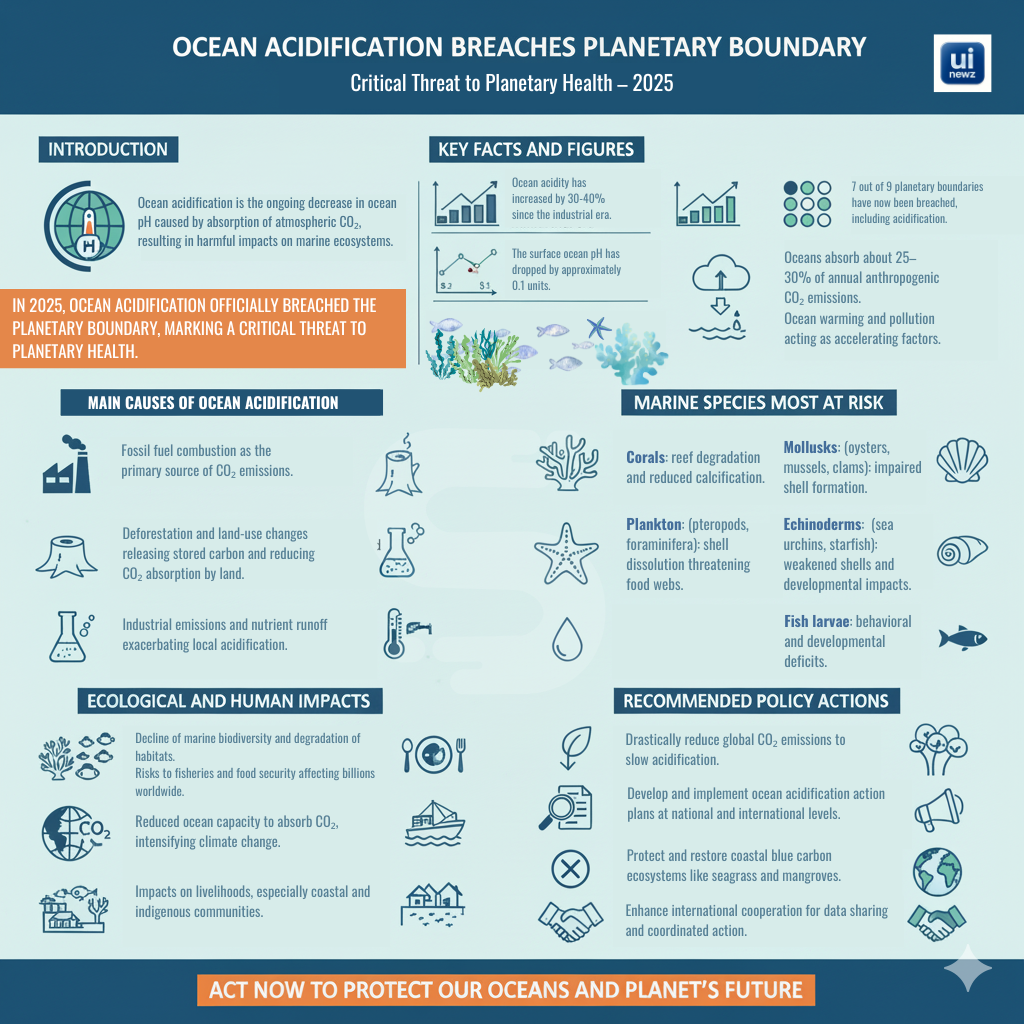
What if the ocean could no longer protect life on Earth? Scientists have now confirmed that ocean acidification has officially breached its planetary boundary for the first time. This alarming milestone marks the seventh of nine critical Earth system thresholds to be crossed, raising urgent concerns about the planet’s ability to sustain life as we know it.
The declaration comes from the international scientific team behind the Planetary Health Check 2025 report, led by Johan Rockström, Director of the Potsdam Institute for Climate Impact Research (PIK) and researcher at the Stockholm Resilience Centre. Coordinated through the PBScience project and supported by the Planetary Guardians initiative, the report analyzed global data and confirmed the boundary breach.
Rockstrom and senior advisors warn that this is not just another environmental statistic; it’s a red alert for humanity, with far-reaching consequences for ecosystems, economies, and human well-being.
What Is Ocean Acidification and Why Does It Matter?
Ocean acidification occurs when excess carbon dioxide (CO₂) from human activities, mainly the burning of fossil fuels, is absorbed into seawater, forming carbonic acid. This lowers the ocean’s pH, increasing acidity by 30 to 40 percent since the industrial era began. This acidification reduces the availability of calcium carbonate, a mineral critical for marine species such as corals, mollusks, and certain plankton to build their shells and skeletons. The disruption threatens the foundation of marine ecosystems and global fisheries.
“The ocean is Earth’s stabilizer,” says Levke Caesar of the Planetary Boundaries Science Lab. “Its increasing acidification, coupled with warming and oxygen loss, is pressuring a system critical to maintaining stable climate conditions.” The ocean absorbs roughly a quarter of the world’s CO₂ emissions, mitigating atmospheric warming at the steep price of rapidly changing chemistry, bringing dire consequences for marine life.
Understanding the Planetary Boundaries
The nine planetary boundaries define Earth’s vital life-support systems, setting safe limits humanity must respect to avoid irreversible environmental damage. Scientists monitor these boundaries like vital signs during a health check, revealing accelerating deterioration and rising risks of dangerous tipping points.
Boris Sakschewski, co-lead of the Planetary Boundaries Science Lab and lead report author, states:
“The interconnections between these boundaries show how local and global pressures can cascade and affect everyone. Securing human wellbeing, economic development, and societal stability requires a holistic approach and collaborative solutions across sectors.”
Nine Planetary Boundaries
- Climate Change: Limits on atmospheric CO₂ to prevent catastrophic warming.
- Biosphere Integrity: Preserving genetic diversity and ecosystem health.
- Land-System Change: Protecting forests and natural landscapes from excessive conversion.
- Biogeochemical Flows: Maintaining nitrogen and phosphorus cycles to avoid ecosystem disruption.
- Freshwater Use: Sustainable consumption of freshwater resources.
- Ocean Acidification: Controlling ocean pH changes to protect marine life (breached in 2025).
- Stratospheric Ozone Depletion: Preventing ozone layer thinning.
- Atmospheric Aerosol Loading: Regulating particulate pollution.
- Novel Entities: Managing synthetic chemicals and pollutants introduced by humans.

Status in 2025: Seven Boundaries Breached
According to the Planetary Health Check 2025, the following seven boundaries are breached:
- Climate Change
- Biosphere Integrity
- Land-System Change
- Freshwater Use
- Biogeochemical Flows
- Novel Entities
- Ocean Acidification (breached for the first time)
Only Stratospheric Ozone Depletion and Atmospheric Aerosol Loading remain within safe limits, thanks to decades of international cooperation, such as the Montreal Protocol and regulations reducing aerosol emissions.
Causes Driving the Ocean Acidification Crisis
Scientists identify several main drivers behind ocean acidification:
- Fossil Fuel Combustion: Massive CO₂ emissions from burning coal, oil, and gas.
- Deforestation and Land-Use Change: Reduced capacity of terrestrial ecosystems to absorb carbon.
- Industrial Emissions and Pollution: Cement manufacturing and nutrient runoff worsen local acidification.
- Warming Oceans: Higher temperatures accelerate acidification and add stress to marine life.
These combined pressures especially affect vulnerable polar regions where acidification progresses fastest.
Marine Species Most at Risk
Species that depend on calcium carbonate for shells and skeletons suffer most:
- Corals: Acidification impairs growth and causes bleaching.
- Mollusks: Oysters, mussels, and clams face difficulty forming shells; larvae are highly vulnerable.
- Echinoderms: Sea urchins and starfish experience developmental issues.
- Calcifying Plankton: Tiny organisms such as pteropods suffer shell dissolution, impacting ocean food webs.
- Fish Larvae: Experience developmental and behavioral impairments, increasing mortality risks.
The decline of these species disrupts marine food chains and threatens coastal communities relying on fisheries for food and economic livelihood.

Urgent Policy Actions Adopted by Scientists
The report emphasizes that reversing the crisis requires immediate, coordinated global action, including:
- Drastic CO₂ Emission Reductions: Transition from fossil fuels to renewables.
- Expanded Monitoring and Research: Global networks for tracking ocean acidification and impacts.
- Development of Acidification Action Plans: Integrating acidification mitigation in national policies.
- Pollution and Nutrient Runoff Control: Supporting healthier coastal waters.
- Ecosystem Restoration: Protecting seagrasses, kelp forests, and mangroves as natural carbon sinks.
- International Cooperation: Multilateral agreements, data sharing, and climate finance.
These measures align closely with the United Nations Sustainable Development Goal 14 on life below water.
The crossing of the ocean acidification boundary is a stark warning: humanity’s footprint is pushing vital Earth systems beyond safe limits, endangering both environmental stability and future generations’ right to a healthy planet.
The ocean’s rapid chemical shifts are not abstract changes, they threaten marine biodiversity, disrupt global food systems, and weaken one of the planet’s most important climate regulators. As Johan Rockström warns, “The ocean is showing signs of failure as a climate stabilizer. This mandates urgent global action to restore planetary resilience.”






